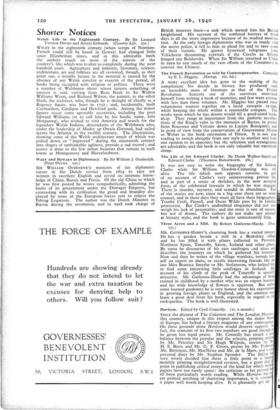Shorter Notices
Welsh Life in the Eighteenth Century. By Sir Leonard Twiston Davies and Averyl Bowards. (Country Life. I55.), WALES in the eighteenth century (when scraps of Norman- French could still be heard in Gower) had changed little since Elizabethan times, and in this admirable book the authors touch on most of the aspects of the country's life, which was to alter so completely during the next hundred years. Agriculture and industry, literature, science, architecture, art and folklore are all reviewed, though, as they point out, a notable lacuna in the material is caused by the absence of any Welsh novelist or essayist of the period, all books being occupied with religion or politics. There were a number of Welshmen about whose careers something of interest is said, varying from Beau Nash to Sir Watkin Williams Wynn, and Richard Wilson, the painter, to the other Nash, the architect, who, though he is thought of chiefly as a Regency figure, was born in x752 ; and, incidentally, built Carmarthen, Cardigan and Hereford gaols. Among the minor figures occur some agreeable eccentrics, including the poet Edward Williams (or to call him by his bardic name, Iolo Morganwg), who wished to visit America and search for the legendary Welsh Indians, descendants of the Welshmen who, under the leadership of Mador ap Owain Gwyned, had sailed across the Atlantic in the twelfth century. The illustrations, showing some of the Welsh architecture much of which was pulled down or " improved " during the nineteenth century into shapes of unthinkable ugliness, provide a sad record ; and justice is done to the few urban beauties that remain in such towns as Montgomery and Haverfordwest.






































 Previous page
Previous page